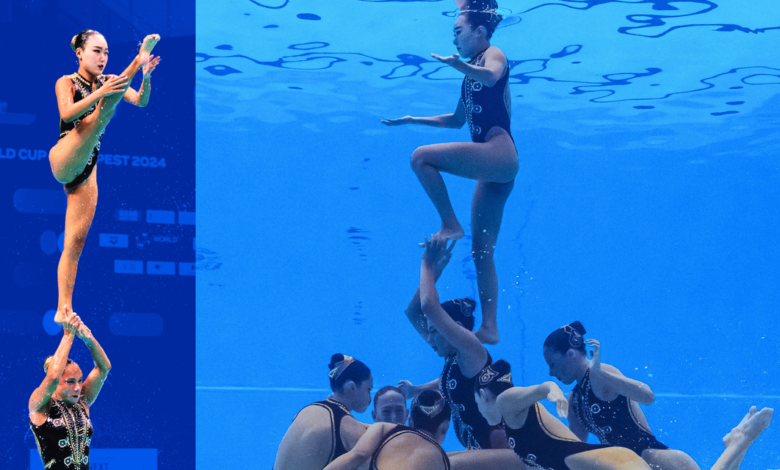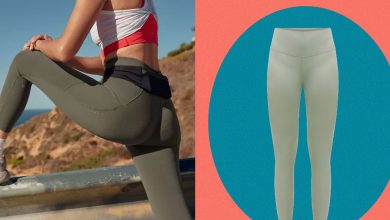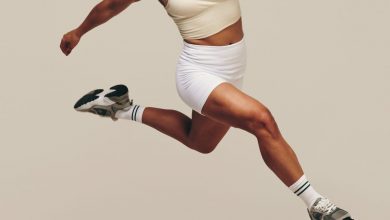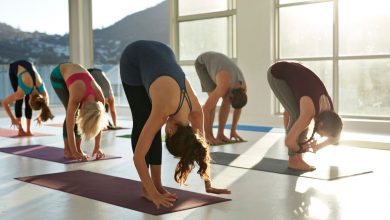What Artistic Swimmers Wish You Knew About This Absolutely Grueling Olympic Sport

While a lot of people think artistic swimming is delightfully antiquated—a bunch of “bathing beauties” in floral swim caps and cherry-lipped smiles—that idea is a tired old stereotype that Daniella Ramirez, a Team USA artistic swimmer set to compete at the 2024 Olympic Games, is sick of hearing. She’s amassed a TikTok following with her post-performance, ASMR-esque “get unready with me” videos, and she’s hoping her content ultimately brings more attention to, and respect for, a grueling (sometimes dangerous) sport she’s spent her entire life—quite literally, her mom and grandmother were athletes too—perfecting.
Ramirez recently spoke with SELF on what it takes to compete in artistic swimming at an Olympic level; why she’s tired of misogynistic, sexualized associations of the sport; how scary being inverted underwater can actually be; and other things she wishes more people knew.
SELF: In artistic swimming, there’s so much emphasis on artistry and beauty—in a predominantly female sport. Do you sometimes feel like outsiders don’t take it as seriously as they should because of this?
Daniella Ramirez: I feel like my goal as a content creator has always been to make our sport more respected and put it in the limelight—to show people how hard it actually is. People tend to associate artistic swimming with Esther Williams, or women diving into a pool sideways in a line. It’s always super hypersexualized, or we’re in the back just being pretty. It’s not like that. We’re not showgirls who touch the bottom of the pool, put an arm and a leg up, and look good. I think it’s very frustrating for me to talk about because it’s so ingrained into American Hollywood that synchronized swimming is background dancing for a pool party. There are a lot of misconceptions there.
Team USA, including Daniella Ramirez, competing at the Doha 2024 World Aquatics Championships.
Maddie Meyer/Getty Images
So that’s one common misconception about artistic swimming—that you can stand on your feet underwater during competition?
People always think we touch the bottom, but I have never, ever touched the bottom of the pool in a routine, ever. What’s another good misconception? The freaking flower caps. Can we end it with the flower caps? Please put that in there. Please end flower caps.
Aside from old sexist media associations, why do you think some people have such a misunderstanding of the sport?
When you look at someone like Simone Biles, I feel like it’s easier to comprehend just how hard her sport is because it’s on land, and we know how physics works. A lot of people tend to think swimming itself is easy, but it’s super hard as it is. Now instead of swimming back and forth, imagine going up and down too, and treading water. That’s artistic swimming.
In Paris, you and your teammates will be in the pool competing for roughly three to three-and-a-half minutes at a time (on three consecutive days). How long does it take to prepare for these performances?
Leading up to the competition, we are training in the pool for about two hours a day, three days a week, for one performance. But that’s just time in the water—we do a ton of other workouts, like CrossFit, but with our mouths taped to help with breath control since we’re underwater so much. We want to make sure that our lungs are really, really strong. We also do a lot of weight training with high reps and pretty low weights. Long before a competition, we’ll also do normal swimming—we’ll swim laps for three hours a day at some points.
Team USA, including Daniella Ramirez, competing at the Doha 2024 World Aquatics Championships.
Quinn Rooney/Getty Images
Speaking of your breathing, you and your teammates spend a *lot* of time underwater—sometimes half of your performance! Has it gotten easier over the years as you’ve grown in your sport?
If you look behind the scenes of any artistic swimming meet, everyone is scared. We have smiles on, but we’re in pain. That’s because, when you aren’t getting enough oxygen while underwater, your body starts to slow down. Sometimes you have trouble moving your arms and legs, and everything is shaking. Artistic swimming is really a competition of who has the highest pain tolerance. Your body is telling you to come up for air, don’t work harder, don’t do anything. You have to learn how to be brave enough to face that pain. But I have seven other people right here with me doing exactly what I’m doing and going through the same pain. They’re not coming up, so I’m not coming up. You smile and make it look easy, but inside, you’re dying.
On top of holding your breath, being mostly inverted, and facing intense fear each time you execute a routine (NBD, obvs!), a big part of your sport is looking the part. How long does it take you to get ready, and how do you keep your makeup and hair looking good, even wet?
The biggest chunk of that time is actually the headpiece I wear—there’s probably 160 pins in it alone. We wear gelatin in our hair to secure everything, but the bun takes up most of the time. Gelling takes probably seven minutes, then you blow-dry it.
Daniella Ramirez, bottom, hoists a fellow team member into the air during the Doha 2024 World Aquatics Championships.
USA Artistic Swimming
USA Artistic Swimming
From there I’ll do makeup, which usually takes 10 to 15 minutes. My biggest thing is using a really, really good waterproof liner—I use the Kat Von D Tattoo Liner. My base makeup can kind of chip during performances, but you can’t really see that when you’re that far away. I use the L’Oreal Paris Infallible Setting Spray, but I also have a special trick to keep things intact for every performance: I dip my makeup sponge in the pool, and then put that chlorinated water on my face…sort of like another layer of setting spray. Not every swimmer does this, but I swear it works. I swear it’s gross. There’s probably pee in that water, but it works for me.
You’ve mentioned that artistic swimming is a predominantly female sport and that you’ve had to defend yourself (and your teammates) from sexist remarks. Though no men will actually be competing at this particular Games, how do you feel about them now being allowed to in general?
Outside of the artistic swimming community, we’ll get a lot of frustrating comments from some men: Why are you guys half-naked? Why do you guys need to be doing the splits all the time? But within the artistic swimming community, the men are the most respectful out of everybody. They’re kind, hardworking, and know how strong we are because we’ve led the way in this sport. Every male artistic swimmer I’ve ever met really, really respects female artistic swimmers. Just because we look lean doesn’t mean that we can’t lift you. We’re just as strong as anybody else, and we deserve the same amount of respect as athletes in any other sport.



